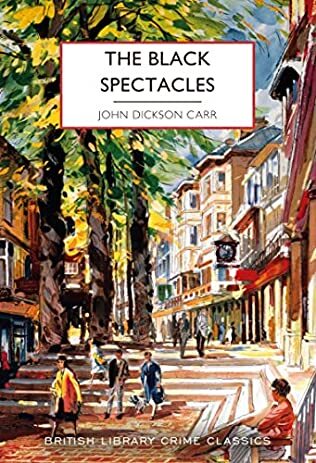The Black Spectacles

A review of The Black Spectacles by John Dickson Carr – 230412
The central conceit behind this book, the tenth in Carr’s Dr Gideon Fell series, is whether a witness’s recall of what they have just seen is ever reliable. Are they just wearing metaphorical black spectacles which clouds and distorts their vision so that their testimony becomes ultimately unreliable? Marcus Chesney believes that this is a case and devises an experiment to prove his thesis. A selected group of guests will watch a tableau unfold before their eyes and then will be asked ten questions about what they have seen. He bets that at least sixty per cent of their answers will be wrong. As further proof the event, to be held at midnight, will be filmed.
The book was originally published in 1939 and has been recently reissued as part of the inestimable British Library Crime Classics series. Carr’s reputation is that of being the master of locked room crimes, but this is more of a closed circle murder mystery, where there are only four suspects. As a consequence the identity of the suspect, which Carr holds back for as long as is humanly possible, is fairly obvious, but the fascination of the book are the sleights of hand and illusions which Chesney employs to prove his case but which ultimately contribute to his demise. Yes, for all his cleverness, Chesney overlooked the possibility that one of his guests would take the opportunity of the atmosphere of illusion and the darkness of the room to force a capsule of poison down his gullet. The man scheduled to play Chesney’s assailant in the tableau is found with a cracked skull in the garden.
The book, which goes by the alternative and more prosaic title of The Problem of the Green Capsule, begins near the House of the Poisoner in Pompeii, which the Chesney entourage are visiting as part of their Mediterranean jaunt and where Inspector Elliot, who leads the investigation of Chesney’s murder, happens to be. He overhears the group discussing Chesney’s theory in relation to a series of poisonings in their village of Sodbury Cross. A poisoner has indiscriminately laced chocolate creams on sale in a local sweet shop with poison and Chesney’s niece, Marjorie Wills, is the local’s prime suspect.
From the second chapter on the focus switches to Sodbury Cross and the aftermath of Chesney’s disastrous experiment. Eliot is one of the lead investigators and Dr Gideon Fell has been called in to add his not inconsiderable intellectual heft to cracking what at first glance seems a mystifying case. Fell quickly realises that some of the ten questions that Chesney had devised for the viewers of his tableau hold the key to the case, particularly the identity and the height of the mysterious visitor.
The solution to the mysterious goings-on lies in a series of substitutions, a dash of magician’s legerdemain, and an analytical dissection of the evidence that the film presents. Naturally, Fell is the first to spot it, but the scales quickly fall from the eyes of his three co-investigators. The culprit and their motivation is fairly clear with the village poisonings little more than a warm-up act for the main event.
This is a book that is all about plot and the cleverness of the problem and its solution rather than a rounded novel that seeks to bring its principal characters alive. It did strike me as being somewhat overlong and might have been more effective as a novella. A more judicious editing of the book would almost certainly have removed the fascinating, although unnecessary, discourse from Fell on the history, characteristics, and motives of poisoners.
If you like your crime fiction to involve a complex problem and a clever solution, then this is for you. I prefer my crime fiction to have a little more, but I found it enjoyable enough. Perhaps one day I will read a Carr that has a locked room mystery!
My takeaway is never to fall in love with one of the prime suspects.



